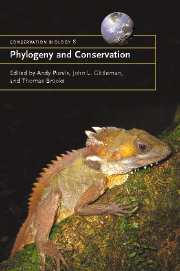Book contents
- Frontmatter
- Contents
- List of contributors
- 1 Phylogeny and conservation
- Part 1 Units and currencies
- 2 Molecular phylogenetics for conservation biology
- 3 Species: demarcation and diversity
- 4 Phylogenetic units and currencies above and below the species level
- 5 Integrating phylogenetic diversity in the selection of priority areas for conservation: does it make a difference?
- 6 Evolutionary heritage as a metric for conservation
- Part 2 Inferring evolutionary processes
- Part 3 Effects of human processes
- Part 4 Prognosis
- Index
- References
6 - Evolutionary heritage as a metric for conservation
Published online by Cambridge University Press: 04 December 2009
- Frontmatter
- Contents
- List of contributors
- 1 Phylogeny and conservation
- Part 1 Units and currencies
- 2 Molecular phylogenetics for conservation biology
- 3 Species: demarcation and diversity
- 4 Phylogenetic units and currencies above and below the species level
- 5 Integrating phylogenetic diversity in the selection of priority areas for conservation: does it make a difference?
- 6 Evolutionary heritage as a metric for conservation
- Part 2 Inferring evolutionary processes
- Part 3 Effects of human processes
- Part 4 Prognosis
- Index
- References
Summary
One of the many things that society considers worthy of conservation is biological diversity (Gaston & Spicer 1998). Many ‘currencies of biodiversity’ (Gaston 1994) have been proposed; the most common approach has simply been to count the number of species in an area (Gaston 1994) and thus identify ‘hotspots’, regions with high species richness (Reid 1998). Other species-based conservation efforts have focused on identifying endemic (Williams & Humphries 1994), threatened (see www.redlist.org) or ecologically important species (Risser 1995; Maddock & Du Plessis 1999). Species with attractive, peculiar, or otherwise special morphological attributes have often been used by conservation organisations for logos and mass appeal (Humphries et al. 1995). Beginning in the early 1990s, several research groups, based primarily in Australia (Faith 1992; Crozier 1992) and the UK (May 1990; Vane-Wright et al. 1991; see also Weitzman 1992), have made strong arguments for considering phylogenetic diversity (PD: some measure of the proportion of the tree of life that a species or group of taxa represents) when ranking conservation units. Because diversity is ultimately the product of descent with modification, branch lengths on a phylogenetic tree predict feature diversity (morphological, genetic) of the lineages they represent (Faith 1992). This suggests that metrics of evolution such as PD might point directly to attributes of diversity worthy of conservation and stewardship.
- Type
- Chapter
- Information
- Phylogeny and Conservation , pp. 120 - 138Publisher: Cambridge University PressPrint publication year: 2005
References
- 29
- Cited by



